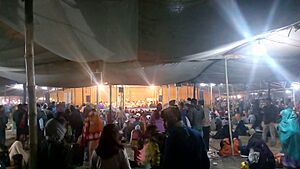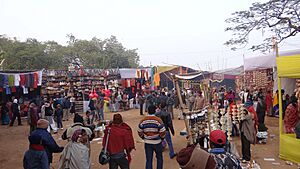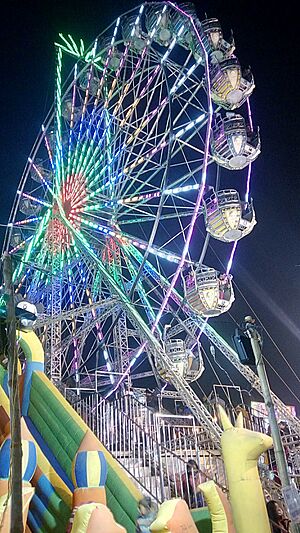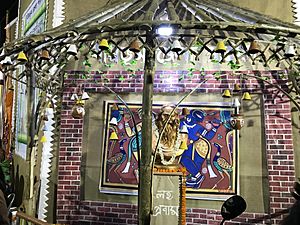Poush Mela facts for kids
Poush Mela (Bengali: পৌষ মেলা) is a fun annual fair and festival held in Santiniketan, a town in the Birbhum District of West Bengal, India. It celebrates the harvest season, which is a very important time for farmers.
The fair usually starts on the 7th day of the Bengali month of Poush. Officially, it lasts for three days. However, many vendors stay longer, sometimes until the end of the month! Since 2017, the fair has been extended to last for six days, giving everyone more time to enjoy it.
One of the most exciting parts of Poush Mela is the live music. You can hear amazing Bengali folk music performances, like baul songs, kirtan (religious songs), and Kobigan (a type of musical debate).
Contents
What is Poush Mela?
Poush Mela is more than just a fair; it's a celebration of culture and tradition. It brings together people from all over to enjoy music, dance, and local crafts. It's a great way to experience the true heritage of West Bengal.
How Poush Mela Started
The story of Poush Mela began with Debendranath Tagore, a very important person in Indian history. On December 21, 1843, he accepted the Brahmo faith. This day, which is also the 7th day of the Bengali month of Poush, became the start of the Poush Utsav (Festival of Poush) in Santiniketan.
Later, a special temple called the Brahma mandir was built in Santiniketan. It was opened on December 21, 1891. To celebrate the temple's anniversary in 1894, a small fair was organized nearby. This small fair grew bigger and bigger over the years. What started as a local gathering now attracts tourists from all around the world!
Poush Mela has been held every year since 1894. However, it had to be paused three times due to very difficult times: during the Bengal famine of 1943, the Direct Action Day of 1946, and the recent COVID-19 pandemic.
At first, the fair was held on the ground next to the Brahma mandir. In the evenings, there used to be amazing firework displays after prayers. As the fair became more popular and needed more space, it moved to a larger field in an area called Purbapalli.
Celebrating the Festival
The Poush Utsav officially begins on the 7th day of Poush, which is usually around December 23. The day starts very early in Santiniketan with the gentle sounds of the shehnai (a traditional Indian instrument).
First, a group called the Vaitalik walks around the ashram (a spiritual retreat), singing beautiful songs. After that, everyone gathers for a prayer meeting at a special place called Chhatimtala. Then, the whole group moves towards Uttarayan, singing more songs along the way. It's a peaceful and musical start to the festival!
Activities at the Fair
Poush Mela is famous for its lively performances of Bengali folk music, especially the energetic baul music. But there's more than just music! You can also enjoy:
- Traditional folk songs and dances
- Exciting tribal sports
Students from Santiniketan also put on wonderful performances, making the festival even more fun and colorful. Each day of the fair is packed with different activities, so there's always something new to see or do. The last day of the fair is often dedicated to people who are closely connected to Santiniketan.
The Fairgrounds
The Poush Mela is a huge event, with about 1,500 stalls set up for visitors. Around 10,000 tourists come to enjoy the fair over its three official days. Santiniketan usually sees about 3,500 tourists daily. But during big festivals like Poush Utsav, this number can jump to 40,000 or even more each day!
Many visitors choose to stay in Santiniketan, which has about 85 lodges that can host around 1,650 people. You can also find rooms for rent if you plan to stay for a few days.
At the stalls, you can find all sorts of interesting things:
- Locally printed fabrics
- Handicrafts made by local artists
- Household items
- Toys for kids
- Delicious food from various food stalls
It's a great place to find unique gifts, enjoy tasty treats, and experience the vibrant local culture.






